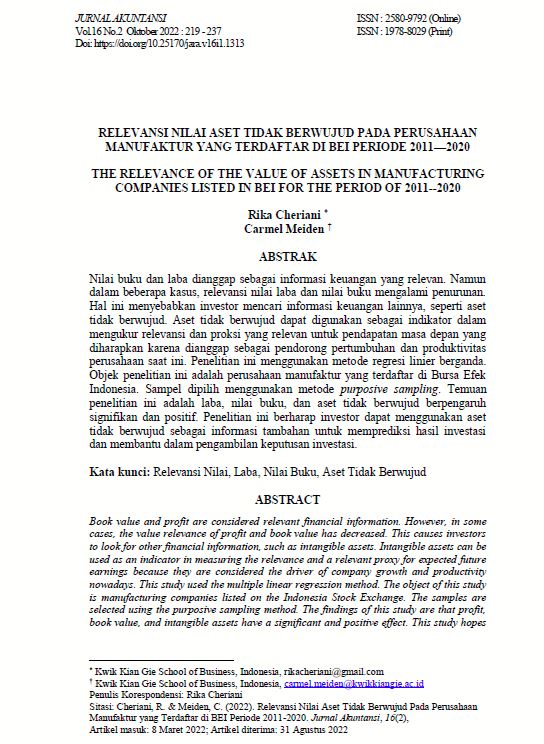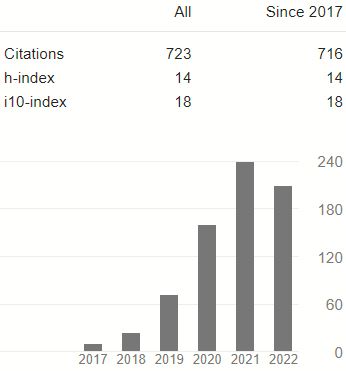RELEVANSI NILAI ASET TIDAK BERWUJUD PADA PERUSAHAAN MANUFAKTUR YANG TERDAFTAR DI BEI PERIODE 2011—2020
DOI:
https://doi.org/10.25170/jak.v16i2.3262Keywords:
Value Relevance, Profit, Book Value, Intangible AssetsAbstract
Book value and profit are considered relevant financial information. However, in some cases, the value relevance of profit and book value has decreased. This causes investors to look for other financial information, such as intangible assets. Intangible assets can be used as an indicator in measuring the relevance and a relevant proxy for expected future earnings because they are considered the driver of company growth and productivity nowadays. This study used the multiple linear regression method. The object of this study is manufacturing companies listed on the Indonesia Stock Exchange. The samples are selected using the purposive sampling method. The findings of this study are that profit, book value, and intangible assets have a significant and positive effect. This study hopes that investors can use intangible assets as additional information to predict investment returns and make investment decisions.
References
Aboody, D., & Lev, B. (1998). The Value Relevance of Intangibles: The Case of Software Capitalization. Journal of Accounting Research, 36, 161.
Al-Ani, M. K., & Tawfik, O. I. (2021). Effect of Intangible Assets on the Value Relevance of Accounting Information: Evidence from Emerging Markets. Journal of Asian Finance, Economics and Business, 8(2), 387–399.
Ang, J. S., Cole, R., & Lin, J. W. (2007). Agency costs and ownership structure. The Journal of Finance, LV(1), 81–106.
Aulia, F. P., Koeswayo, P. S., & Bede, D. (2020). Relevance of Intangible Asset, Equity Book, and Earning Value on Stock Price in Information Technology Era. Journal of Accounting Auditing and Business, 3(1), 135.
Collins, D. W., Pincus, M., & Xie, H. (1999). Equity Valuation and Negative of Equity. The Accounting Historians Journal, 74(1), 29–61. Retrieved from papers3://publication/uuid/A16FB5E0-5B91-4445-9F6D-94C8F82D2624
Dahmash, F. N., Durand, R. B., & Watson, J. (2009). The Value Relevance and Reliability of Reported Goodwill and Identifiable Intangible Assets. British Accounting Review, 41(2), 120–137.
Eisenhardt, K. M. (1989). Agency Theory : An Assessment and Review. Academy of Management Review, 14(1), 57–54.
Ely, K., & Waymire, G. (1999). Intangible Assets and Equity Valuation in the Pre-SEC Era. (April).
Fama, E. F. (1970). Efficient Capital Markets: A Review of Theory and Empirical Work. The Journal of Finance, 2771–2771.
Financial Accounting Standards Board (FASB). (1978). Statement of Financial Accounting Concepts No. 1. Financial Accounting Foundation, 1–91.
Francis, J., & Schipper, K. (1999). Have Financial Statements Lost Their Relevance? Journal of Accounting Research, 37(2), 319–352.
Hartono, J. (2017). Teori Portofolio dan Analisis Investasi (Edisi Kesebelas). Yogyakarta: BPFE-YOGYAKARTA.
Hazan, E., Smit, S., Woetzel, J., Cvetanovski, B., Krishnan, M., Gregg, B., … Hjartar, K. (2021). Getting Tangible About Intangibles. McKinsey Global Institute, (June), 40.
Hyunmi, J. (2018). The Value Relevance and Reliability of Intangible Assets: Evidence from South Korea. Global Business & Finance Review, 23(2), 98–107.
Jennings, R., LeClere, M. J., & Thompson, R. B. (1997). Evidence on the Usefulness of Alternative Earnings per Share Measures. Financial Analysts Journal, 53(6), 24–33.
Jensen, M., & Meckling, W. (1976). Theory of the firm: Managerial Behavior, Agency Costs, and Ownership Structure. Journal of Financial Economics, 3(4), 305–360.
Ji, H. (2018). The Value Relevance and Reliability of Intangible Assets: Evidence from South Korea. Global Business and Finance Review, 23(2), 98–107.
Kieso, D. E., Wegandt, J. J., & Warfield, T. D. (2019). Intermediate Accounting (17th ed.). Wisconsin: Wiley.
Kohler. (1983). Kohler’s Dictionary For Accountants (6th Editio; W. W. Cooper & Y. Ijiri, eds.). New Jersey: Prentice Hall.
Madhani, P. M. (2012). Intangible assets: Value drivers for Competitive Advantage. Best Practices in Management Accounting, 30, 147–164.
Ohlson, J. A. (1995). Earnings, Book Values, and Dividends in Equity Valuation. Contemporary Accounting Research, 11(2), 661–687.
Oliveira, L., Rodrigues, L. L., & Craig, R. (2010a). Intangible assets and value relevance: Evidence from the Portuguese stock exchange. British Accounting Review, 42(4), 241–252.
Suwardjono. (2016). Teori Akuntansi (Ketiga). BPFE-YOGYAKARTA.

Downloads
Published
Issue
Section
License
Authors who publish with this journal agree to the following terms:
- Authors retain copyright and grant the journal right of first publication with the work simultaneously licensed under a Creative Commons Attribution-ShareAlike 4.0 International License that allows others to share the work with an acknowledgment of the work's authorship and initial publication in this journal.
- Authors are able to enter into separate, additional contractual arrangements for the non-exclusive distribution of the journal's published version of the work (e.g., post it to an institutional repository or publish it in a book), with an acknowledgment of its initial publication in this journal.
- Authors are permitted and encouraged to post their work online (e.g., in institutional repositories or on their website) prior to and during the submission process, as it can lead to productive exchanges, as well as earlier and greater citation of published work.














